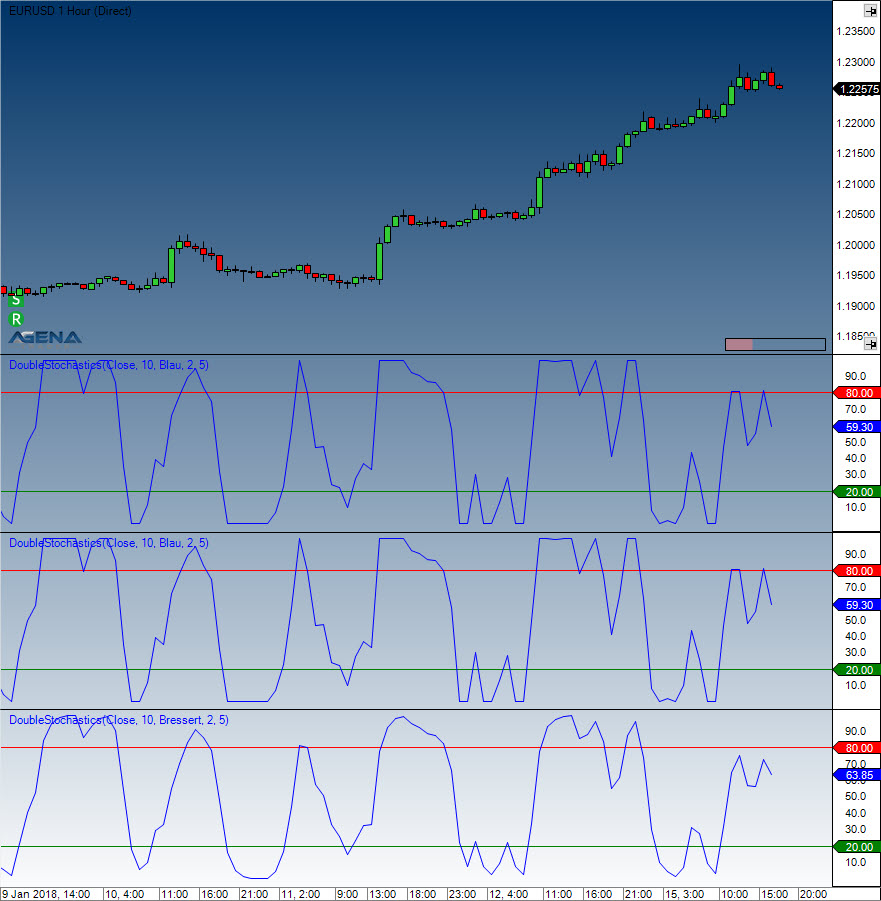Double Stochastics (DSS)
Description
William Blau was the developer of the Double Smoothed Stochastic (DSS), which is a double-smoothed stochastic indicator. After a while, it was improved upon by Walter Bressert as a variation of the double-smoothed stochastic. Smaller changes in the price movements cause this indicator to react more sensitively, and it also produces more signals than the one Blau developed. The Bressert version therefore also illustrates extreme zones more clearly than the Blau version.
Regardless of the various calculation methods used, the DSS always stays within a scale of 0 to 100. The extreme zones in the developed stochastics are the same as for the original stochastics. The upper extreme area is marked at 80, and the lower extreme zone at 20 - these values cannot be changed. For many applications, it is wise to include an additional middle line at 50, and to adapt this to the circumstances as needed.
Interpretation
Values above 80 are seen as overbought, and below 20 as oversold. In addition, signals are produced by the signal line’s behavior and movements into and out of the extreme zones.
Usage
DoubleStochastics(int period)
DoubleStochastics(int period)[int barsAgo]
DoubleStochastics(int period, DoubleStochasticsMode mode, int EMA-Period1)
DoubleStochastics(IDataSeries inSeries, int period, DoubleStochasticsMode mode, int EMA-Period1)
DoubleStochastics(int period, DoubleStochasticsMode mode, int EMA-Period1)[int barsAgo]
DoubleStochastics(IDataSeries inSeries, int period, DoubleStochasticsMode mode, int EMA-Period1)[int barsAgo]
DoubleStochastics(int period, DoubleStochasticsMode mode, int EMA-Period1, int EMA-Period2)
DoubleStochastics(IDataSeries inSeries, int period, DoubleStochasticsMode mode, int EMA-Period1, int EMA-Period2)
DoubleStochastics(int period, DoubleStochasticsMode mode, int EMA-Period1, int EMA-Period2)[int barsAgo]
DoubleStochastics(IDataSeries inSeries, int period, DoubleStochasticsMode mode, int EMA-Period1, int EMA-Period2)[int barsAgo]
//For the value of %K
DoubleStochastics(int period).K[int barsAgo]
DoubleStochastics(IDataSeries inSeries, int period).K[int barsAgo]
DoubleStochastics(int period, DoubleStochasticsMode mode, int EMA-Period1).K[int barsAgo]
DoubleStochastics(IDataSeries inSeries, int period, DoubleStochasticsMode mode, int EMA-Period1).K[int barsAgo]
DoubleStochastics(int period, DoubleStochasticsMode mode, int EMA-Period1, int EMA-Period2).K[int barsAgo]
DoubleStochastics(IDataSeries inSeries, int period, DoubleStochasticsMode mode, int EMA-Period1, int EMA-Period2).K[int barsAgo]Return value
double
When using this method with an index (e.g. DoubleStochastics(...)[int barsAgo] or DoubleStochastics(...).K[int barsAgo]), the value of the indicator will be issued for the referenced bar.
Parameters
inSeries Input data series for the indicator
period Number of bars included in the calculations (default: 10)
mode Method of calculation, possible inSeries are Blau, Blau2, Bressert
EMA-Period1 Periods for the EMA
EMA-Period2 Periods for the second EMA
Visualization

Example
Last updated